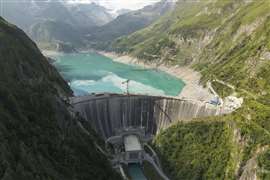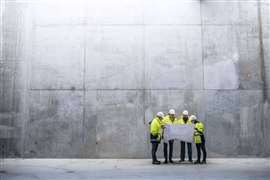Climate change… construction’s hottest topic
04 August 2023
The escalating climate change crisis driven by increasing greenhouse gas (GHG) emissions has become a global emergency with far-reaching implications for the economy, society, and environment.
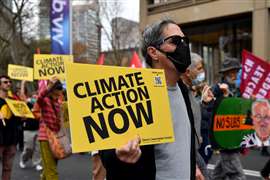 Climate change rallies and protests worldwide are becoming commonplace. Photo: Reuters/BIANCA DE MARCHI
Climate change rallies and protests worldwide are becoming commonplace. Photo: Reuters/BIANCA DE MARCHI
A tipping point appears to have been reached; the daily global average surface air temperatures in the first half of July 2023 were likely the highest ever recorded on Earth.
Remarkably, for 14 days in July, surface air temperatures soared above 17°C (62.6°F) — peaks unseen before.
Climate Urgency
This may surprise many, but it’s not unforeseen, considering that all ten of the warmest years recorded since recording began in 1880 have occurred since 2010.
Elevated temperatures not only intensify the frequency and severity of heatwaves, currently exemplified by the extreme heatwaves sweeping across Europe, but also amplify the impacts of other extreme weather events such as prolonged droughts, uncontrollable wildfires, and heavy rains leading to catastrophic flooding.
The frequency of such events has seen a marked upturn in the last two decades. This escalating concern necessitates urgent action, prompting an increased onus on governments and businesses to curtail their environmental impacts.
The ultimate aim is to limit the temperature rise to 1.5°C above pre-industrial levels in accordance with the Paris Agreement on Climate Change.
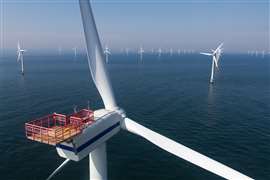 The construction industry's utilisation of renewable energy is significantly on the rise. Photo: Adobe Stock
The construction industry's utilisation of renewable energy is significantly on the rise. Photo: Adobe Stock
Construction’s contribution to climate change
Among all industries, the built environment tops the list as the most significant contributor to GHG emissions, accountable for more than one third of global carbon emissions, one third of global resource use, and 40% of worldwide energy consumption.
This includes emissions directly produced by the construction industry, such as those from machinery used on construction sites, and emissions during the operational phase of a building’s lifespan.
The operational phase of a building — when it’s in use — is responsible for substantial emissions, chiefly due to heating, cooling and electricity consumption.
Indirect emissions primarily stem from energy-intensive production processes of raw materials like cement, steel, and glass and from transporting these materials and equipment to construction sites. Concrete production alone accounts for approximately 8% of global CO2 emissions, surpassing global carbon emissions from aviation.
If the cement industry were a nation, it would rank as the world’s third-largest emitter of carbon dioxide, following the US and China.
Furthermore, the construction industry significantly contributes to waste generation, responsible for 40% of global waste.
Inefficient resource usage, design flaws, and a lack of recycling and reuse strategies result in considerable waste, often relegated to landfills, producing methane, a highly potent greenhouse gas.
 Technolology has the potential to make construction more efficient and, subsequently, more sustainable. Photo: Leica
Technolology has the potential to make construction more efficient and, subsequently, more sustainable. Photo: Leica
Climate change and its impact on construction
Conversely, climate change can substantially influence the operation and efficiency of the construction sector.
With extreme weather events becoming more common due to climate change, there’s a rising need for buildings that can withstand these conditions. This demands the construction industry to innovate and build more resilient structures.
Governments worldwide are also imposing stricter regulations on carbon emissions and energy efficiency in an effort to counteract climate change. This influences construction practices, driving the industry towards ‘green building’ techniques.
Additionally, increased awareness of climate change is shifting consumer preferences towards buildings with lower environmental impacts, leading to a growing demand for sustainable construction.
Climate mitigation and adaptation strategies for construction
The construction industry is facing a two-pronged fight against climate change. It must accelerate its efforts to reduce or prevent greenhouse gas emissions to decelerate global warming while simultaneously adapting to increase resilience to climate impacts.
Without adaptation, the construction industry (and society as a whole) will experience the damaging impacts of climate change that are already occurring and will continue to occur even with strong mitigation efforts.
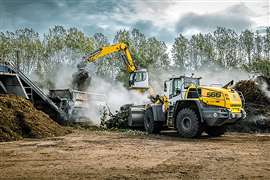 Recycling is increasingly a hot topic in the construction industry. Photo: Liebherr
Recycling is increasingly a hot topic in the construction industry. Photo: Liebherr
Some of the mitigation and adaption strategies the industry can promote include:
Green Building Practices – Constructing energy-efficient buildings can play a crucial role in mitigating climate change.
The industry is embracing sustainable or ‘green’ building practices that aim to reduce environmental impact. This includes using energy-efficient design and building methods, incorporating renewable energy sources, and using sustainable or recycled materials.
Climate-resilient infrastructure – Climate change increases the risk of extreme weather events, so the sector is working to design and build infrastructure that can withstand these challenges.
Digital technology and innovation – New technologies are being utilised to help reduce the sector’s environmental impact. This includes using Building Information Modeling (BIM) for better planning and resource management or artificial intelligence (AI) and machine learning to optimise building design for energy efficiency.
Also, technologies like 3D printing and drones fitted with sensors can be harnessed to improve the efficiency and sustainability of construction projects.
Lifecycle assessment – It is critical to assess the direct and indirect environmental impact of buildings across their entire lifecycle, from the extraction of raw materials to construction, operation and, finally, demolition or repurposing.
This leads to a circular economy approach, where waste is minimised, and materials are reused or recycled wherever possible.
 Dr Sreejith Balasubramanian of Middlesex University Dubai. Photo: S Balasubramanian
Dr Sreejith Balasubramanian of Middlesex University Dubai. Photo: S Balasubramanian
Carbon offsetting – Some companies are investing in carbon offset projects, which help to compensate for the emissions produced in the construction process. This might include investing in renewable energy projects or reforestation efforts.
Government regulations and standards – In many countries, new regulations and standards push the industry towards more sustainable practices.
For instance, stricter energy codes require buildings to be more energy-efficient, and some nations are implementing carbon pricing or cap-and-trade systems that encourage lower emissions.
Training and education – Construction professionals are educated and trained in sustainable building practices. This includes architects, engineers, builders, contractors, and other industry workers.
To conclude, the relationship between the construction industry and climate change is complex and multidimensional.
The construction sector is a significant contributor to climate change and is impacted by it. With approximately 70% of the world’s population expected to live in urban areas by 2050, the environmental fallout due to increased construction activities is likely to worsen in the future.
Therefore, the industry requires urgent, large-scale action for climate change mitigation and adaptation, facilitated by adopting more sustainable and energy-efficient construction practices.
However, achieving this demands a collaborative effort from all industry stakeholders, including policymakers, construction companies, building professionals, and consumers.
|
ABOUT THE AUTHOR Dr Sreejith Balasubramanian is Associate Professor and Chair at the Office of Research, and Head of the Centre for Supply Chain Excellence at Middlesex University Dubai. For more information on this topic, Dr Balasubramanian can be reached at [email protected] |
STAY CONNECTED


Receive the information you need when you need it through our world-leading magazines, newsletters and daily briefings.
CONNECT WITH THE TEAM








